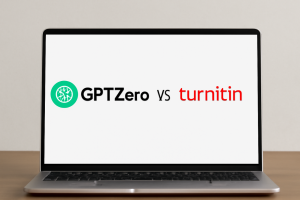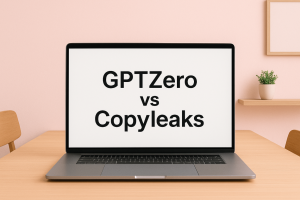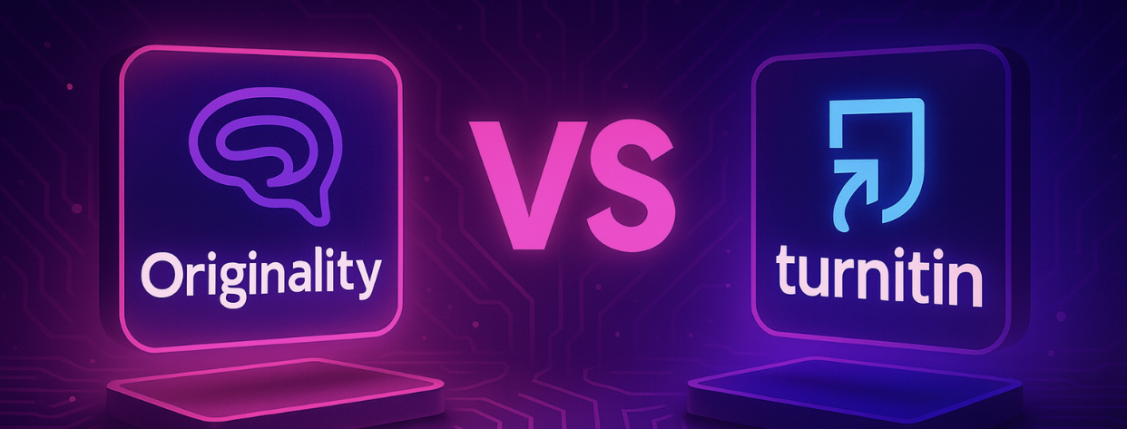Key Takeaways
- Originality.ai delivers only 76% accuracy in detecting AI-generated content with serious false positive problems, while Turnitin claims over 90% accuracy but lacks independent verification of real-world performance.
- Both tools use flawed detection methods that frequently misidentify human writing as AI-generated, with Originality.ai particularly notorious for flagging human content as machine-written.
- Turnitin integrates with learning management systems, but this convenience doesn’t solve the fundamental reliability issues that plague all AI detection technology.
- Instead of fearing AI detectors, focus on creating high-quality content. AmpCast generates quality expert content in 8 content formats and distributes these contents to 300+ platforms, enabling real business growth.
Detection Tool Essentials: What You Need to Know
AI detection tools work by analyzing writing patterns, linguistic variations, and statistical markers that supposedly differentiate human writing from machine-generated text. However, these same patterns often appear in high-quality human writing, leading to false accusations against legitimate authors. These tools examine factors like perplexity (the randomness of word choice) and burstiness (the variation in sentence structure and complexity), but human writers naturally vary in these characteristics.
The promise of effective detection requires balancing sensitivity (catching AI content) with specificity (avoiding false accusations against human writers), but current technology fails at both. What detection companies market as “sophisticated algorithms” often amount to pattern-matching systems that mistake formal writing, technical content, or consistent quality as signs of machine generation.
The best AI detection tools must continuously evolve as language models improve, but they’re losing this technological arms race. What worked against GPT-3 proved completely inadequate against GPT-4 or Claude 2. Despite this, two AI detection tools, Originality AI and Turnitin, seem to be making waves.
How AmpiFire Works:
- Research & Target: Find high-demand topics your buyers search for
- Create & Repurpose: AmpiFire’s AmpCastAI generates news articles, blogs, videos, podcasts, infographics, slideshows, and social posts
- Distribute & Amplify: Auto-publish to 300+ sites including Google News, YouTube, Spotify, and major news networks
Get more traffic from people who want to buy your stuff, and powerful “As Seen On” trust badges for your site.
Do It Yourself (with AI), Done For You Content, & 100% Managed Organic Growth options available.
Grow Your Free Traffic From Everywhere
Overview of Originality.ai Capabilities
Founded in 2021, Originality.ai was built specifically to address the challenges of AI-generated content rather than adapting existing plagiarism infrastructure.
However, real-world testing reveals that this focused approach has not solved the fundamental reliability problems that plague all AI detection technology.
How Originality.ai’s Detection Algorithm Works
Originality.ai employs a multi-layered detection strategy combining statistical analysis, linguistic pattern recognition, and machine learning models trained specifically on AI-generated text.
The system analyzes numerous text characteristics, including sentence structure variability, word choice patterns, and logical flow markers that supposedly differentiate between human and AI writers. However, this comprehensive approach frequently mistakes characteristics of good human writing as indicators of AI generation.
Accuracy Rates: What the Data Actually Shows
Contrary to marketing claims suggesting much higher performance, independent testing indicates Originality.ai correctly identifies only approximately 76% of AI-generated content, making it far less reliable than advertised.
The platform shows inconsistent performance across different AI models, with accuracy varying significantly depending on content type and editing level. False positive rates prove even more problematic, with testing revealing that Originality.ai incorrectly flags human-written content as AI-generated at alarming rates.
Real-world testing demonstrates Originality.ai’s fundamental flaws. When Scribbr tested the tool by scanning their own human-written blog post introduction, Originality.ai incorrectly indicated there was a 94% chance it was AI-generated, despite being entirely human-authored.
A common complaint among users is that “the only way for Originality.ai to accurately identify human-written text is if it contains grammar, spelling, and syntactic errors.” This requirement essentially means the tool mistakes good writing for AI writing, making it counterproductive for any context where quality matters.
Turnitin: AI Detection Accuracy
In 2023, in response to the AI writing revolution, Turnitin launched its AI Writing Indicator as an extension of its existing plagiarism detection infrastructure.
However, this addition leverages the company’s reputation rather than proven detection capabilities, creating potential for widespread false accusations across institutional networks.
Turnitin’s AI Writing Indicator Technology
Turnitin’s AI detection technology employs a proprietary algorithm that analyzes statistical patterns in text that supposedly correlate with AI generation.
The system examines linguistic features, including predictability, variance patterns, and structural regularities that the company claims differ between human and machine writing.
Detection Performance Claims vs Reality
Turnitin claims approximately 90%+ accuracy in detecting AI-generated text in academic contexts, but these figures seem significantly lower in independent testing. One study evaluating the accuracy of Turnitin AI detector showed that the tool demonstrates variable accuracy rates depending on the type of content being analyzed.
The tool performs most effectively with purely human-generated texts, achieving a 93% accuracy rate by correctly identifying 28 of 30 samples. However, its performance declines significantly when analyzing AI-generated content, with only 77% accuracy for pure AI texts and 63% accuracy for disguised AI-generated materials.
The tool struggles most with hybrid content that combines both human and AI writing, achieving just 43% accuracy in this category. False positive rates remain relatively low at 3.3%, with only one human text incorrectly flagged as AI-generated. However, false negative rates are more concerning, with 23% of pure AI texts not being identified as 100% AI-generated.
Overall, while Turnitin excels at identifying completely human-written content, its reliability decreases substantially when dealing with AI-generated content that has been modified, disguised, or combined with human writing, highlighting current limitations in AI detection technology.
Detection Accuracy Face-Off: Originality.ai vs Turnitin
| Feature / Metric | Originality.ai | Turnitin |
| Accuracy Rate on AI Content | Approximately 76% in independent testing | 77% accuracy for pure AI texts and 63% accuracy for disguised AI-generated materials |
| False Positive Rate | High false positives: 5–7%, including misflagging formal and legal texts | Lower, about 1–3 |
| Detection Methodology | Multi-layered: statistical analysis + linguistic and semantic coherence | Statistical pattern analysis focusing on linguistic features |
| Performance on Edited/Paraphrased AI Content | Poor reliability, detection drops below 50% with edits | Similar poor detection with human-edited AI content |
| Known Limitations | High false positives flagging good human writing, poor detection on sophisticated AI, no broad LMS use | High false negatives, variable accuracy rate, unquantified, institutional lock-in risks |
Why Content Quality Matters More Than Algorithmic Scores
Rather than relying on flawed detection technology that creates more problems than it solves, content creators and educators should focus on transparency, quality, and building authentic relationships with their audiences.
The obsession with detecting AI use has distracted from more important questions about content value, audience engagement, and authentic communication.
Instead of worrying about detection scores that frequently provide false information, focus on creating content that genuinely serves your audience and builds lasting relationships with your community.
Create High Quality Content: The AmpiFire Advantage
While unreliable AI detection tools create confusion and false accusations, focusing on quality content helps you build authentic audience engagement. That’s where AmpiFire comes in.
AmpCast transforms your expertise into eight distinct content formats: news articles, blog posts, podcasts, videos, infographics, slideshows, and social media posts, then automatically distributes them across 300+ high-authority platforms, including Google News, YouTube, Spotify, and major news networks.
This comprehensive distribution strategy maximizes your ROI by replacing time-consuming tactical work like individual content creation and manual publishing, freeing you to focus on building meaningful client relationships and growing your business.
When audiences encounter your content across multiple trusted platforms, it naturally builds brand credibility and establishes your expertise more effectively than any detection tool could verify.
Rather than obsessing over unreliable detection scores, let AmpiFire create high quality content for you, while you focus on delivering genuine value and building authentic connections with your audience.
Frequently Asked Questions
Do these tools store student papers in their databases?
Turnitin stores submitted papers in its database by default to improve plagiarism detection capabilities, though institutions can opt out of this practice.
By contrast, Originality.ai does not permanently store full-text submissions unless users explicitly enable this feature, instead processing content for detection and then discarding it.
How often do these AI detectors update their algorithms?
Both platforms regularly update their detection algorithms to improve accuracy and address emerging evasion techniques. Turnitin typically releases major algorithm updates quarterly, with minor improvements implemented more frequently.
Originality.ai employs a continuous improvement model with smaller updates deployed approximately monthly, allowing for more rapid adaptation to new AI writing models and detection challenges.
Can either tool detect AI content written in languages other than English?
Turnitin offers limited AI detection capabilities for major European languages, including Spanish, French, German, Italian, Portuguese, and Dutch, though with lower accuracy rates than its English detection.
Originality.ai currently focuses primarily on English content with experimental support for Spanish and French. The platform has acknowledged the technical challenges of multilingual detection and is prioritizing accuracy improvements for English content.
How can I avoid AI detection issues while still creating efficient content at scale?
Rather than trying to evade unreliable AI detection tools that frequently flag human content incorrectly, focus on creating authentic value through high-quality content and strategic distribution. AmpCast transforms your expertise into multiple content formats and distributes it across 300+ trusted platforms. This approach builds genuine audience engagement and brand credibility without relying on flawed detection technology that creates more problems than it solves.
Author
-

CEO and Co-Founder at AmpiFire. Book a call with the team by clicking the link below.
Related Posts

GPTZero vs Originality.ai: Which is the Better AI Detector?
Compare GPTZero vs Originality.ai AI detectors. Learn accuracy rates, features, pricing, and which tool works best for your content needs.

GPTZero vs Turnitin: Which is the Better AI Detector?
Compare GPTZero vs Turnitin AI detectors with our expert analysis covering accuracy, pricing, and integration to choose the best detection…

Is ChatGPT “Nigerian English”? How AI Detection Is Rigged
Nigerian English, 1980s political speeches, and 19th-century literature have one thing in common: they’re often mistaken for AI.

Does Google Hate AI Content? ChatGPT’s Stance on Detection, SEO, Indexing, & Duplicate Penalties
Learn how Google views AI Chat GPT content through the lens of Chat GPT. Discover the impact of indexing, duplicate…

GPTZero vs ZeroGPT AI Detector Mega Test: Best Accuracy & False Positives?
We tested GPTZero and ChatGPT on dozens of AI- and human-written texts (including casual blogs, short stories, and even political…

GPTZero vs Copyleaks: Which is the Better AI Detector?
Compare GPTZero vs Copyleaks AI detectors. Learn accuracy rates, features, pricing, and which tool works best for different business needs…









